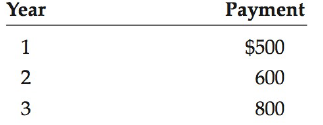Start with the partial model in the file Ch 04 Build a Model.xlsx from the textbook's website.
Question:
Start with the partial model in the file Ch 04 Build a Model.xlsx from the textbook's website.
Answer the following questions, using a spreadsheet model to do the calculations.
a. Find the FV of $1 ,000 invested to earn 10% after 5 years. Answer this question by using of Money a math formula and also by using the Excel function wizard.
b. Now create a table that shows the FV at 0%, 5%, and 20% for 0, 1, 2, 3, 4, and 5 years. Then create a graph with years on the horizontal axis and FV on the vertical axis to display your results.
c. Find the PV of $1,000 due in 5 years if the discount rate is 10%. Again, work the problem with a formula and also by using the function wizard.
d. A security has a cost of $1,000 and will return $2,000 after 5 years. What rate of return does the security provide?
e. Suppose Canada's population is 30 million people, and its population is expected to grow by 2% per year. How long will it take for the population to double?
f. Find the PV of an annuity that pays $1,000 at the end of each of the next 5 years if the interest rate is 15%. Then find the FV of that same annuity.
g. How would the PV and FV of the annuity change if it were an annuity due rather than an ordinary annuity?
h. What would the FV and PV for parts a and c be if the interest rate were 10% with semiannual compounding rather than 10% with annual compounding?
i. Find the PV and FV of an investment that makes the following end-of-year payments. The interest rate is 8%.

j. Suppose you bought a house and took out a mortgage for $50,000. The interest rate is 8%, and you must amortize the loan over 10 years with equal end-of-year payments. Set up an amortization schedule that shows the annual payments and the amount of each payment that goes to pay off the principal and the amount that constitutes interest expense to the borrower and interest income to the lender. Remember that interest rates on mortgage loans are compounded semiannually.
(1) Create a graph that shows how the payments are divided between interest and principal repayment over time.
(2) Suppose the loan called for 10 years of monthly payments, with the same original amount and the same nominal interest rate. What would the amortization schedule show now?
AnnuityAn annuity is a series of equal payment made at equal intervals during a period of time. In other words annuity is a contract between insurer and insurance company in which insurer make a lump-sum payment or a series of payment and, in return,... Compounding
Compounding is the process in which an asset's earnings, from either capital gains or interest, are reinvested to generate additional earnings over time. This growth, calculated using exponential functions, occurs because the investment will... Discount Rate
Depending upon the context, the discount rate has two different definitions and usages. First, the discount rate refers to the interest rate charged to the commercial banks and other financial institutions for the loans they take from the Federal...
Step by Step Answer:

Financial Management Theory And Practice
ISBN: 978-0176583057
3rd Canadian Edition
Authors: Eugene Brigham, Michael Ehrhardt, Jerome Gessaroli, Richard Nason





